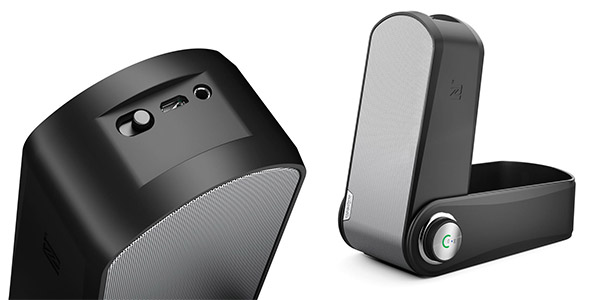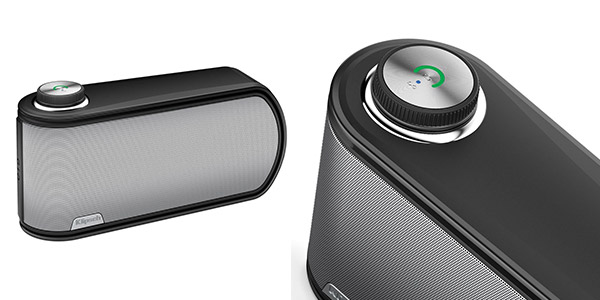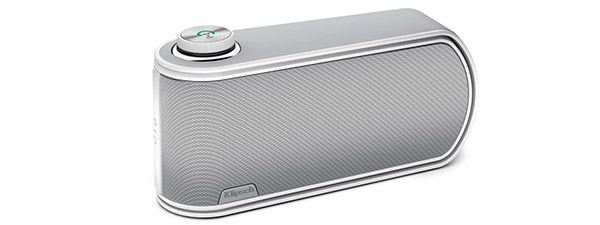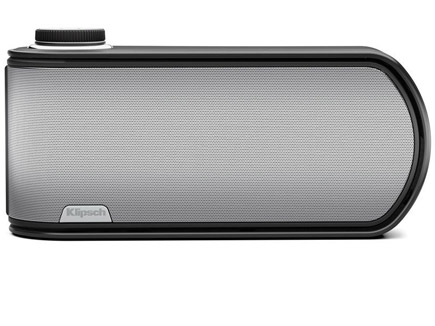Tom's Guide Verdict
Few Bluetooth speakers can match the Gig Portable Music System's emphasis on bass, but other models handle vocals better.
Pros
- +
Excellent bass for a portable Bluetooth speaker
- +
Multipurpose knob on speaker controls audio playback
- +
Siri compatibility
Cons
- -
Weak vocals and treble tones
- -
Shape makes it awkward to carry
Why you can trust Tom's Guide
Most portable Bluetooth speakers sacrifice bass in the name of convenience. Klipsch knows better than that. Befitting a company acclaimed for home theater and stereo speakers, Klipsch's Gig Portable Music System ($199) delivers detailed low-end frequencies that similar speakers ignore altogether. The Gig also offers a built-in speakerphone, Near Field Communication (NFC) support and a unique multifunction button. But is this speaker the best in its price range?
Design

The Gig's unique form helps it stand out in a sea of portable Bluetooth speakers. The hard rectangular case (7 x 3.6 x 2.1 inches) tapers and rounds off toward the end. Klipsch wraps the case in a band (available in seven colors), which can serve as a stand; this is a nice touch and makes it easy to steady the unit on any flat surface. We found the shape difficult to hold, though; it was a little too big to comfortably fit in our hand.
MORE: Best Bluetooth Speakers
The Gig also has more heft than some other portable Bluetooth speakers, weighing 1.4 pounds. The Ultimate Ears Boom is 1.2 pounds, but the Bose SoundLink Mini weighs an even heftier 1.5 pounds.
The Gig's design innovation is a single button that controls the volume and also lets you control playback without touching your mobile device. Push the button once to play or pause, or twice to advance to the next song. It's a welcome feature when your mobile device is across the room and you're next to the speaker.
The Gig's silicon case with a metal grill covering the drivers looks like it could handle a beating. Klipsch doesn't claim any water-resistance capability, though, so we wouldn't use this device near the pool.
Setup and Use

The Gig paired quickly with iOS and Android devices. To put the speakers in discovery mode, you push up the power slider for three seconds. On an Android device, you just have to go to Settings and look for the speaker listed in Available Devices. If you have an NFC-equipped Android device, just touch the speaker and the mobile device together for the fastest pairing. You'll see a pop-up on your mobile device that asks if you want to pair it with the speaker. Click Yes, and you're set. In iOS, go to Settings > Bluetooth, where the Klipsch Gig should appear under Devices.
Alternatively, you can go the old-fashioned route and use the included 22-inch cable with 3.5mm jacks to connect directly from the headphone port on your mobile device to the Aux-In port on the speaker. This method uses less power on your mobile device and ensures connection quality, though it limits how far your mobile device can be from the speaker.
The speaker shuts itself off after being idle for 10 minutes (good for conserving power), and it requires you to manually reconnect to your mobile source (an inconvenience that quickly becomes an annoyance). Other Bluetooth speakers we tested automatically reconnect when you power the speaker on and your mobile device is in range.
Klipsch claims a range of 30 feet for Bluetooth connectivity, and we found that number to be accurate indoors with a clear line of sight. Outside, the range dips to about 10-15 feet, as with other Bluetooth speakers we've tested.
Audio Performance
If you love the low end, this is the portable Bluetooth speaker for you. The Gig reproduced the complex bass action on St. Vincent's "Digital Witness" with aplomb, especially compared to other portable Bluetooth speakers such as the UE Boom and JBL Pulse. Those speakers didn't even come close to the oomph the Gig pumped out. The low-end dominance also suited Lorde's "Team," with its bass-drum emphasis.
On the other hand, the bass can overwhelm songs that dwell in the mid and high ranges, like the detailed acoustics on Beck's "Heart Is a Drum." The saxophones on Charles Mingus' "Goodbye Pork Pie Hat" came across thin and lacking in depth, though the piano resonated well. Similarly, the orchestra on the overture to Felix Mendelssohn's "Midsummer's Night Dream" sounded two-dimensional.
MORE: 12 Best Music Apps
The weakness of mid and treble tones may result from the Gig's two 1-inch drivers for the mid and high, compared to the two 1.5-inch units that models like the UE Boom include.
Speakerphone
The Gig includes speakerphone capability that made it easy to hear the person on the other end of a call, while clearly relaying our end of the conversation. Thanks to Siri integration, iOS users can go completely hands free when using the speakerphone to make calls or perform other commands. Push down the knob on the Gig for two seconds, and you'll hear the familiar chime that signals Siri is listening.
Battery Life
Klipsch says the Gig's battery will last 12 hours at average volume (though only four when cranked all the way up). After several hours of testing over the course of a week, the battery indicator on the control button still showed two of three bars.
The Gig features a built-in battery and charges via microUSB. The unit ships with a wall plug, or you can charge it using your computer's USB port or any USB wall charger.
Verdict

Among the many portable Bluetooth speakers with a $199 price tag, few can match the Gig's emphasis on bass, which makes it a compelling choice for those with music collections full of hip-hop, electronic dance music and other low-frequency-filled songs. Add to that the built-in speakerphone and Siri integration, and you have a very handy device. But if you like vocals, strings, horns and other mid and high sounds, you'll be better off the with the Fugoo Style or UE Boom, which cost the same and offer fuller sound.
Specs
Two 1-inch drivers
Two 2-inch passive radiators
Dimensions: 3.6 x 7 x 2.1 inches
Weight: 1.4 pounds
Inputs: Bluetooth, 3.5mm auxiliary input
NFC
Follow Michael Gowan @zebgowan and on Google+. Follow us @tomsguide, on Facebook and on Google+.

Michael Gowan is a freelance technology journalist covering soundbars, TVs, and wireless speakers of all kinds of shapes and sizes for Tom’s Guide. He has written hundreds of product reviews, focusing on sound quality and value to help shoppers make informed buying decisions. Micheal has written about music and consumer technology for more than 25 years. His work has appeared in publications including CNN, Wired, Men’s Journal, PC World and Macworld. When Michael’s not reviewing speakers, he’s probably listening to one anyway.

